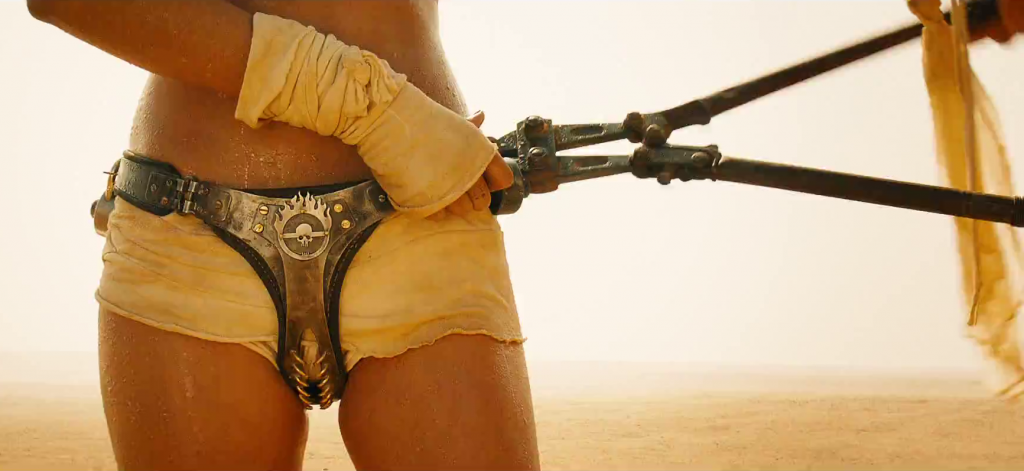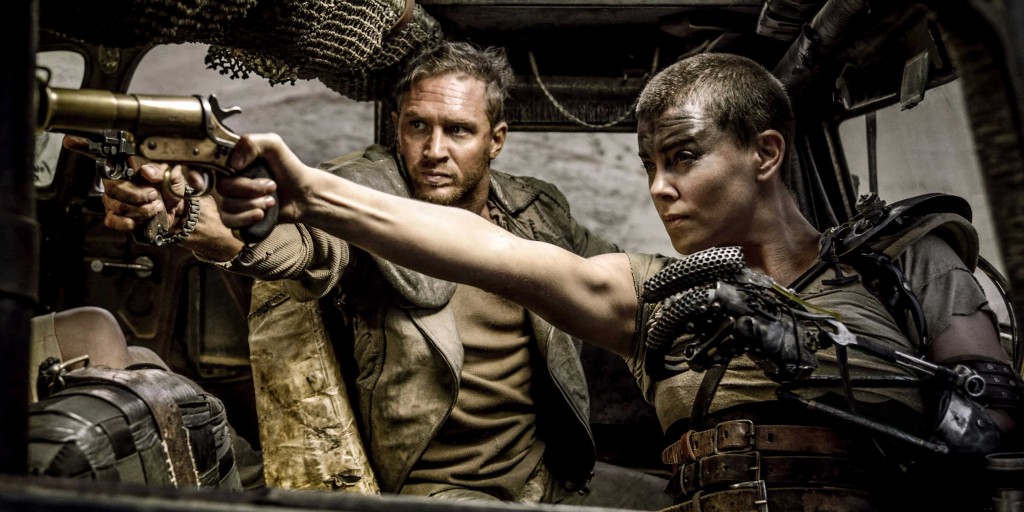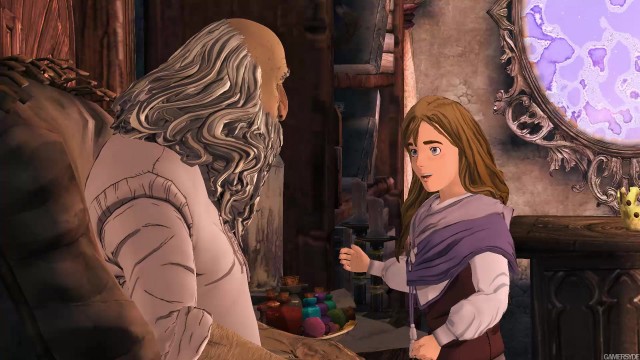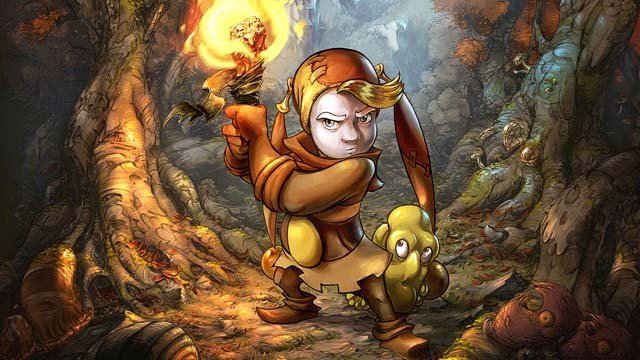The latest entry in the Mad Max franchise, Mad Max: Fury Road, employs its grim, post-apocalyptic world to comment on a good many contemporary concerns. There’s the obvious one, which was confirmed to be director George Miller’s inspiration for the series: the oil crisis and ongoing concerns over the sustainability of gas, which, in the context of the film, has led to a world where the supply of gas is controlled and rationed by warlords. It also tackles the ever-growing threat of water scarcity in drought-ridden parts of the world and worries over corporate monopolization of water, which plays out in cult leader and main villain Immortan Joe’s strict control and rationing of his village’s water supply. Then there’s also the tried and true themes of the dangers of cultism and of single men possessing too much power, which is eerily presented in the War Boys, Immortan Joe’s personal army of young men who presumably all suffer from some sort of radiation poisoning, and their idolization of the tyrannical leader. These themes, while certainly presented rather powerfully and elegantly in Mad Max: Fury Road, are somewhat expected in a film set in a dystopian world that uses modified cars and trucks as its primary source of action. What I didn’t know when I dismissed Mad Max: Fury Road‘s trailer as I sat waiting for Avengers: Age of Ultron to begin was how this very “outwardly masculine” film would use its setting to comment on reproductive rights issues faced by women in our world today, how well it would not only do this but also how well it would tell a very feminist story, and how much it would get Mens’ Rights Activists (MRAs) up in arms.
Mad Max: Fury Road‘s trailer is unassuming. Sure, Charlize Theron’s character Imperator Furiosa gets a decent amount of screentime, but most advertisements for the movie highlights it fast-paced, nonstop, rather gorgeous action. For all intents and purposes, Mad Max: Fury Road seems like a “dude movie” – something that so targets traditionally/stereotypically male interests that distributors don’t even care about targeting a female demographic at all. So when I saw that multiple news sites were reporting that MRAs were calling for a boycott over the film and were just generally up in arms over its “feminist agenda,” I was intrigued enough to go see the film for myself just to discover what all the fuss was about (and yes, okay, also to stick it to the MRAs just a little bit). After critically watching and being thoroughly impressed with the film, I can see why the content and underlying message of this impressively feminist movie, filled with multiple engaging and interesting female characters who band together to secure both reproductive and political freedom from a tyrannical man, might scare or intimidate MRAs and disrupt their decidedly sexist, anti-feminist campaign.
Warning: some spoilers are described below. I’ve tried to be as sparse and ambiguous as I can but some specific points or scenes are necessary for my analysis to follow.
Amidst a sprawling desert wasteland, the only oasis is a makeshift kingdom ruled by the previously mentioned Immortan Joe, a warlord who maintains control of his malnourished and impoverished people by hoarding resources and indoctrinating the youth to worship him. In order to produce healthy male heirs, he keeps and shelters attractive women to act as sex slaves and “Breeders” and “Wives.” These women (who are presumably all pregnant, but it was only really evident on one), guided by Imperator Furiosa, a female member of Immortan Joe’s army gone rogue, abduct a war rig and, along with the help of the titular character, attempt to find a secret haven for mothers and imprisoned women. Throughout the movie, the primary objective of the “Wives” (Angharad, Capable, Cheedo, Toast, and the Dag) is to obtain freedom for both themselves and their unborn children and not be relegated as “things” or property.
The commentary on how reproductive and sexual freedom is a basic human right for women is fairly apparent even just from the bare bones description of the plot. After all, here is a group of women who have decided to take their fate, and the fate of their potential children, in their own hands and refuse to let their bodies be used for what is essentially a political agenda created and dictated by men. In fact, director George Miller even brought on Eve Ensler, the feminist author of The Vagina Monologues, as a consultant to ensure their stories, feelings, and motivations were realistic for those escaping sexual slavery (a fact that shows in the very realistic/believable characters). But the allegory doesn’t end there. At one point in the film, Immortan Joe exclaims that they must get these women back because the babies within them are “his property,” to which they all but reply “f*** no.” By placing these women in the “hero’s party,” constructing the film in a way that makes the audience root for them to achieve their goal, and by painting Immortan Joe and his misogynistic ways as the clear villain, it becomes not only a potent allegory for the debate regarding to whom the choice of what to do with a pregnancy falls, but it makes it clear that the choice should belong to the woman. But perhaps one of the most extreme and thought provoking portions of the film comes in the form of a scene where Immortan Joe, after “recovering” one of his very pregnant escaped “Wives” who is on the brink of death, cares little about her condition and instead insists that they try to salvage the may-or-may-not-be-alive baby, which they literally cut out of her. Although rather gruesome, it’s potent commentary on how anti-choice rhetoric often prioritizes saving the fetus over the life of the woman.
It’s not surprising that the MRA community is up in arms over this rather pro-women’s choice take on reproductive rights considering their stance that the autonomy of women to decide what to do with a pregnancy is oppressive to men and a violation of “paternal rights” because it denies the man’s input. Many advocate that the man must be consulted before a woman can make a decision like the choice to get an abortion, and it’s this sort of controlling rhetoric that manifests physically and literally in the world of Mad Max: Fury Road. By presenting women who are empowered by their decision to claim their own bodily autonomy, the movie presents just the kind of message MRAs like to viciously oppose.
Furthermore, throughout the course of the movie, the women learn that they can survive independently of Immortan Joe’s control and twisted “protection” and learn to rely instead on themselves and each other. Founded on what they claim to be the “natural” gender roles of the male protector and female submissive and motherly figure, the MRA movement likes to use rhetoric to paint the picture that the man’s “protection” against a hostile outside world is beneficial. Mad Max: Fury Road does just this to an extreme: the outside wasteland world is indeed full of countless dangers and, to an extent, it’s likely some of the “Wives” – who during the time in their compound had access to food and water and other privileges that the city’s other citizens seemingly do not – saw themselves as “protected” there. Although the movie begins after the women have made their decision to leave, at one point, after witnessing the harsh cruelties and violence of the world around her, one of the women questions their decision. But ultimately, throughout the course of the film, the women come to realize that the real danger is Immortan Joe and the values he stands for, and that they are more than capable of surviving on their own.
Aaron Clarey, the MRA behind the charge to boycott Mad Max: Fury Road, had the following to say on his blog:
“The truth is I’m angry about the extents Hollywood and the director of Fury Road went to trick me and other men into seeing this movie. Everything VISUALLY looks amazing. It looks like that action guy flick we’ve desperately been waiting for where it is one man with principles, standing against many with none.
But let us be clear. This is the vehicle by which they are guaranteed to force a lecture on feminism down your throat. This is the Trojan Horse feminists and Hollywood leftists will use to (vainly) insist on the trope women are equal to men in all things, including physique, strength, and logic. And this is the subterfuge they will use to blur the lines between masculinity and femininity, further ruining women for men, and men for women.”
Despite all of the content I’ve discussed above, it seems that Mad Max: Fury Road‘s biggest sin is essentially removing Max, the man, from the focus of what they consider to be a “man’s story” and giving the focus and heroism to Furiosa and the “Wives.” Although Max certainly helps, he is rarely the initiator or protector. Instead Furiosa takes that role, with the “Wives” stepping up to defend themselves and their convoy when they have to. In this way, Furiosa assumes the role of the hero character, a role that is almost exclusive to men in most mainstream action movies, while Max takes more of a submissive role. She embodies traditionally male traits and isn’t shy to make use of them. Furthermore, she’s never sexualized, never objectified or made the object of desire or even really (although that’s up to your interpretation) made a love interest; she’s unabashedly the hero and it’s clear that she’s not there to fill some sexual component of an action film. While in the previous films, Max was more of the idealized male figure many have come to expect and that allows male audiences to project themselves into, his lessened role and lessened importance could be seen as “threatening,” particularly as Furiosa assumes his role. And just as the “Wives” learn that they don’t need to be under the control of Immortan Joe and can be independent, perhaps many MRAs are afraid that not only will the empowered female leads become more normalized in cinema, but that male exceptionalism and stories will no longer dominate our culture. After all, would these MRAs be so upset if Furiosa’s role was eliminated and if Max exclusively did all the saving? Or if she was simultaneously the “sidekick” and a piece of eye candy?
So is there a “feminist agenda” in this latest incarnation of Mad Max and creeping across Hollywood that seeks to give female characters autonomy and make well-portrayed female characters the new action movie staple? Maybe, and if that’s the case, I’m certainly not complaining.







5 thoughts on “The Road to an MRA’s Hell is Paved with the Fury of Women: Exploring Mad Max’s “Feminist Agenda””
I was already looking forward to seeing this movie but doubly so now, good read. ^.^
Get excited, it’s worth it! Thank you!
I must admit, if it wasn’t for the MRA’s boycott I would have never thought about seeing this movie. And I’m so glad I did 😀 I enjoyed it so much and it made me feel enthusiastic about the future of action movies. I want more stories that feature these kind of characters.
I probably wouldn’t have gone to see it either so I totally understand! Haha
Full disclosure, I’m from Southeast Asia so our views on feminism and MRAs (which seem to be a uniquely US phenomena) are potentially very different.
In all honesty, I would love to see more “Feminist agenda” movies to be as kick ass as this one. Whereas I applause the obvious girl power aspects of the film, I want to applaud the overall character depth and variety that they have, especially among the Wives (whom I only knew the names of because of looking at IMDB).
Angharad, as the de facto leader, is defiant. Toast, one of my favorite ones, brought an important set of skills, knowing the ammo and the weaponry, eschewing the typical useless damsel-in-distress. Capable showed that affection can bloom even in the oddest of places. Dag was fun with her venomous words. Even Cheedo, in her cowardice and insecurity, was refreshing. They were not cardboard cutouts of the “Strong Female Character”. They were variety of characters that despite having vastly different personalities shared a common goal, get the fuck away from Immortan Joe. This movie is essentially a glorified escort mission (in video game terms) but damn does it make a good example on how to make everyone in the party interesting.
Furiosa was easily the star of the show but she is wise as well. She knows when to handle shit on her own and when it’s more prudent to ask for help. Mad Max ain’t a slouch either. He finished the job that Furiosa started in the Bullet Judge fight. Truth be told, even Max would know that this ain’t his story. He just kinda got roped in, but that doesn’t he can’t put a good show.
also Doof Warrior is a mothafreakin’ boss XD